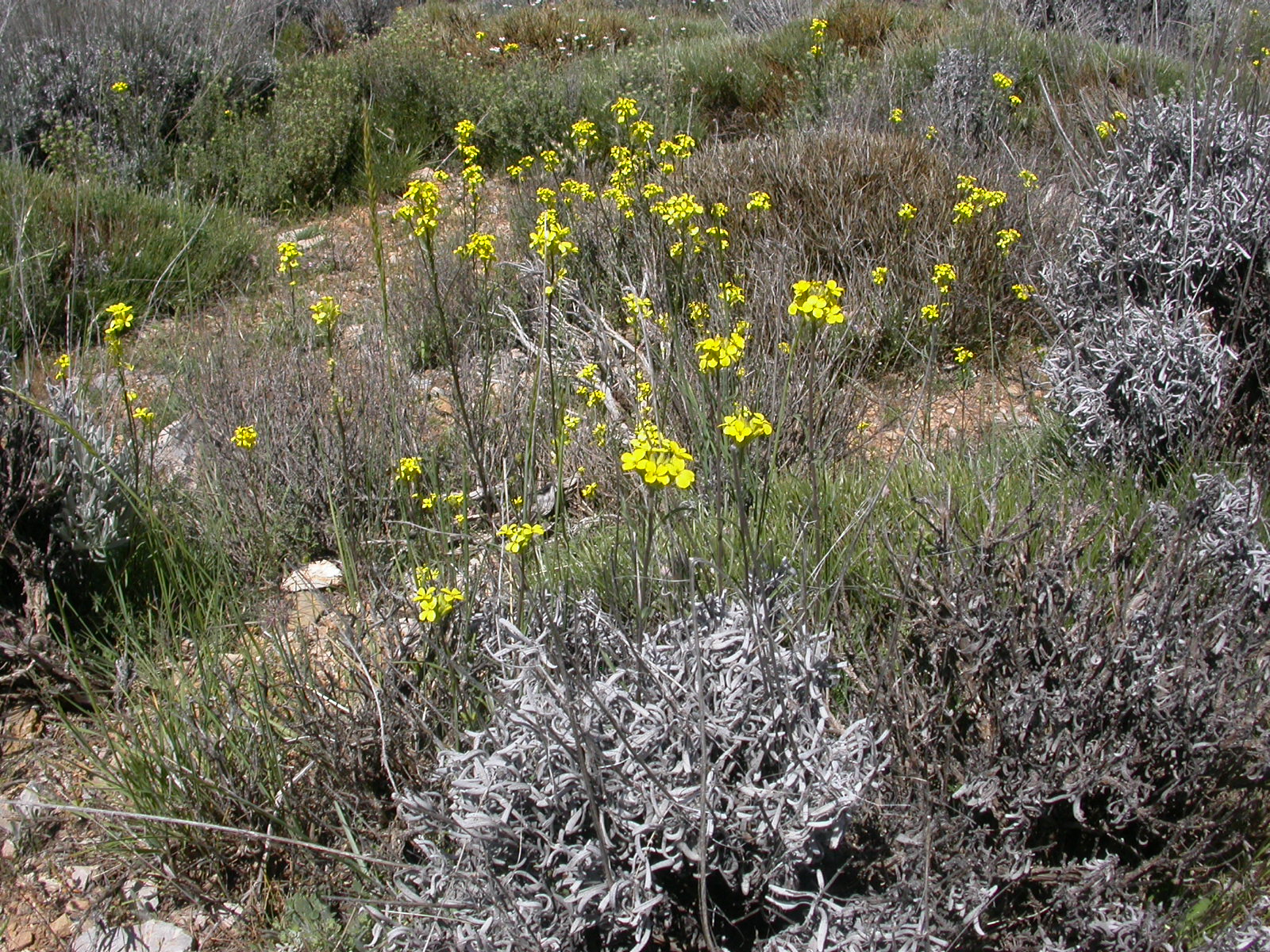- Erysimum mediohispanicum
taxobox
name = E. mediohispanicum
image_caption = "Erysimum mediohispanicum"
regnum =Plantae
unranked_divisio =Angiosperms
unranked_classis =Eudicots
unranked_ordo =Rosids
ordo =Brassicales
familia =Brassicaceae
genus = "Erysimum "
binomial = "Erysimum mediohispanicum"
binomial_authority = (Polatschek , 1979)|"Erysimum mediohispanicum" is a perennial short-lived monocarpic herb found in many montane regions of eastern
Spain where it is distributed between 800–2,000 m above sea level and inhabits forests, scrublands, and shrublands. It occupies two main regions in theIberian peninsula , one in the north (Soria toLleida ) and the other in the south-east (Granada ,Albacete ,Jaen , and Almería provinces).This species belongs to the "nevadense"
complex species , together with five more Iberian species ("Erysimum nevadense ", "Erysimum gomezcampoi ", "Erysimum ruscinonense ", "Erysimum rondae ", "Erysimum mexmuelleri ").Life cycle
Seeds germinate during early spring (March to early May).
Seed germination is very high, usually higher than 80% in most localities. Seedlings grow for 2–4 years as vegetative rosettes. Much mortality occurs during the first summer due to the usually severe summer drought occurring in the Mediterranean environment. Surviving individuals flower during their second year, and after flowering most individuals die. However, there are a low proportion of individuals that reproduce more than once, this proportion of iteroparous individuals varying geographically.Morphology
Plant morphology is very plastic in this species. Reproductive plants produce one to eight reproductive stalks from 8 to 130 cm tall. Each flowering stalk can display between 5 and approx. 100 bright yellow (up to several hundred), hermaphroditic, slightly protandrous flowers arranged in corimbous inflorescences.
Pollination biology
Flowers have a tetradynamous
androecium , with four long and two shortstamens . Each flowers contain a variable number ofovules , ranging between 15 and 30 aprox. Flowers have a non-fused corolla tube formed by the union of thepetals andsepals . Flowers produce minute amount ofnectar in four nectaries located in the base of the corolla tube, around theovary . Corolla shape is extremely variable, ranging from radially to bilaterally symmetric even in the same population.Flowers are visited by more than one hundred species of insects belonging to the order
Hymenoptera ,Diptera ,Coleoptera ,Lepidoptera andHeteroptera . Although this crucifer is self-compatible, it needs pollen vectors to produce full seedset. In fact, plants experimentally excluded from pollinators set only 16% of the fruits set by naturally pollinated plants. Abundant pollinators are the beetles "Melighetes maurus" (Nitidulidae ), "Dasytes subaeneus" (Dasytidae ), "Malachius laticollis" (Malachidae ) and "Anthrenus " sp. (Anthrenidae ), the solitary bees "Anthophora leucophaea" (Anthophoridae ) and "Halictus simplex" (Halictidae ), and the beeflies "Bombylius " spp. (Bombyliidae ).Herbivory
In southeastern Spain, reproductive individuals are consumed by many different species of herbivores. Some floral buds do not open because they are galled by flies ("Dasineura" sp.,
Cecidomidae ). Several species of sap-suckers (primarily the bugs "Eurydema oleraceae", "E. fieberi", "E. ornata", and "Corimeris denticulatus") feed on the reproductive stalks during flowering and fruiting. In addition, stalks are bored into by a weevil species (presumably "Lixus ochraceus",Curculionidae ), which consumes the inner tissues, whereas another weevil species ("Ceutorhynchus chlorophanus",Curculionidae ) develops inside the fruits, living on developing seeds and acting as predispersal seed predators. The stalks are browsed by Spanish ibex ("Capra pyrenaica ",Bovidae ), which consume flowers and mostly green fruits. Dispersed seeds are consumed by woodmice ("Apodemus sylvaticus ",Muridae ), several species of birds ("Fringilla coelebs", "Serinus serinus", and "Carduelis cannabina"Fringillidae , among others), several species of medium-sized granivorous beetles ("Iberozabrus " sp.Carabidae , among others), and ants ("Lasius niger ", "Tetramorium caespitum", "Cataglyphis velox" and "Leptothorax tristis"). These animals feed on the seeds from late August to early April. Seedlings and juveniles are sometime injured by ibex, sheep, wild boars ("Sus scrofa ",Suidae ), hares ("Lepus granatense",Leporidae ), and voles ("Pitimys " spp.,Arvicolidae ), although most seedlings die due to summer drought and seed quality.eed dispersal
"E. mediohispanicum" produce tiny seeds (less than 0.5 mg) that are autochorously (by gravity) dispersed during August and September (about 40-60 days after pollination), when the valves of the dehiscent fruits (
siliquae ) open due to moving vegetation, wind rain or physical contact. Dispersal distance is very short in this species, just very few seeds travelling farther than 1 meter from the plant source.Seed dispersal distance is positively related to flowering stalk height, taller plants usually dispersing seeds farther.External links
* [http://evoflor.ugr.es/ evoflor] a web page on Erysimum floral evolution
* [http://www.rjb.csic.es/floraiberica/ Flora Ibérica]
Wikimedia Foundation. 2010.
